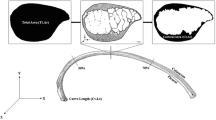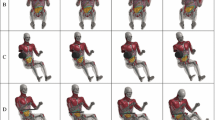Abstract
Thorax injuries mainly due to rib fractures have been associated with high rates of morbidity and mortality in motor vehicle crashes. Thoracic biomechanics has been studied extensively, but there are no robust biomechanical response targets for ribs that consider age, sex, body size, and vulnerability factors. The objective of this study was to generate biomechanical targets for human rib response with respect to age, sex, and body size. Two-hundred sixty-one ribs from 171 individuals were dynamically loaded to failure in anterior–posterior bending. Force and displacement at the time of fracture in young adults were greater than in older adults (p < 0.0001). Sex differences were found in those over 40 years old (p < 0.0001). Fracture force from 5th percentile female ribs was lower than 50th and 95th male (p < 0.005). Vulnerable ribs were successfully identified by examining the percentile of both force and displacement at the time of fracture in the proposed samples. The biomechanical targets generated in this study will have useful applications to computational thorax and rib models to aid in injury prevention measures.






Similar content being viewed by others
References
Agnew, A. M., M. Murach, E. Misicka, K. Moorhouse, J. Bolte and Y. Kang. The effect of body size on adult human rib structural properties. IRC-17-105: 728-736. In: Proceedings of the International Research Council on the Biomechanics of Impact (IRCOBI), Antwerp, Belgium. 2017
Agnew, A. M., M. Murach, V. M. Dominguez, A. Sreedhar, E. Misicka, A. Harden, J. Stammen, K. Moorhouse, and Y. Kang. Sources of variability in structural bending response of pediatric and adult human ribs in dynamic frontal impacts. Stapp Car Crash J. 62:119–192, 2018.
Baudrit, P., A. Petitjean, P. Potier, X. Trosseille, and G. Vallencien. Comparison of the thorax dynamic responses of small female and midsize male post mortem human subjects in side and forward oblique impact tests. SAE Technical Paper; 2014 Nov 10.
Benjamin, D. J., J. O. Berger, M. Johannesson, B. A. Nosek, E. J. Wagenmakers, R. Berk, K. A. Bollen, B. Brembs, L. Brown, C. Camerer, and D. Cesarini. Redefine statistical significance. Nat. Hum. Behav. 2(1):6, 2018.
Carroll, J., T. Adolph, C. Chauvel, M. Labrousse, X. Trosseille, C. Pastor, A. Eggers, S. Smith, and D. Hynd. Overview of serious thorax injuries in European frontal car crash accidents and implications for crash test dummy development. In: Proceedings of the International Research Council on the Biomechanics of Impact (IRCOBI), Hannover, Germany 2010. pp. 217–234, 2010.
Carter, P. M., C. A. Flannagan, M. P. Reed, R. M. Cunningham, and J. D. Rupp. Comparing the effects of age, BMI and gender on severe injury (AIS 3 +) in motor-vehicle crashes. Accid. Anal. Prev. 72:146–160, 2014.
Charpail, E., X. Trosseille, P. Petit, S. Laporte, F. Lavaste, and G. Vallancien. Characterization of PMHS ribs: a new test methodology. SAE Technical Paper; Nov 9, 2005.
Crowder, C., and L. Rosella. Assessment of intra- and intercostal variation in rib histomorphometry: its impact on evidentiary examination. J. Forensic Sci. 52:271–276, 2007.
Currey, J. D., and G. Butler. The mechanical properties of bone tissue in children. J. Bone Joint Surg. 57(6):810–814, 1975.
Davis, M. L., B. Koya, J. M. Schap, and F. S. Gayzik. Development and full body validation of a 5th percentile female finite element model. SAE Technical Paper; Nov 7, 2016.
Forman, J., G. S. Poplin, C. G. Shaw, T. L. McMurry, K. Schmidt, J. Ash, and C. Sunnevang. Automobile injury trends in the contemporary fleet: belted occupants in frontal collisions. Traffic Injury Prev. 6:1–6, 2019.
Hu, J., J. D. Rupp, and M. P. Reed. Focusing on vulnerable populations in crashes: recent advances in finite element human models for injury biomechanics research. J. Automot. Saf. Energy. 3:295–307, 2012.
Kang, Y. S., A. M. Agnew, C. B. Hong, K. Icke, and J. H. Bolte. Elderly PMHS Thoracic Responses and Injuries in Frontal Impacts. In: Proceedings of the International Research Council on the Biomechanics of Impact (IRCOBI), Antwerp, Belgium, pp. 539–557, 2017.
Katzenberger, M., D. L. Albert, M. A. Agnew, and A. Kemper. Effects of sex, loading rate, and age on the tensile material properties of human rib cortical bone. J. Mech. Behav. Biomed. Mater. 102:103410, 2020.
Kemper, A. R., C. McNally, C. A. Pullins, L.J. Freeman, S. M. Duma, and S. W. Rouhana. The biomechanics of human ribs: material and structural properties from dynamic tension and bending tests. SAE Technical Paper, 2007.
Kemper, A. R., C. McNally, E. A. Kennedy, S. J. Manoogian, A. L. Rath, P. N. Tracy, J. D. Stitzel, E. P. Smith, S. M. Duma, and F. Matsuoka. Material properties of human rib cortical bone from dynamic tension coupon testing. SAE Technical Paper, 2005.
Kent, R., J. L. Forman, and O. Bostrom. Is there really a “cushion effect”?: a biomechanical investigation of crash injury mechanisms in the obese. Obesity. 18(4):749–753, 2010.
Kent, R., D. Lessley, and C. Sherwood. Thoracic response to dynamic, non-impact loading from a hub, distributed belt, diagonal belt, and double diagonal belts. SAE Technical Paper; Nov 1, 2004.
Kent, R., W. Woods, and O. Bostrom. Fatality risk and the presence of rib fractures. In: Proceedings of Advances in Automotive Medicine. Vol. 52, p. 73, 2008.
Kimpara, H., M. Iwamoto, K. Miki, J. B. Lee, P. C. Begeman, K. H. Yang, and A. I. King. Biomechanical properties of the male and female chest subjected to frontal and lateral impacts. In: Proceedings of the International Research Council on the Biomechanics of Impact (IRCOBI). 2003.
Kitagawa, Y., and T. Yasuki. 2013. Correlation among seatbelt load, chest deflection, rib fracture and internal organ strain in frontal collisions with human body finite element models. In: IRCOBI Conference Proceedings (No. IRC-13-36).
Kroell, C.K., D.C. Schneider, and A.M. Nahum. Impact tolerance and response of the human thorax II. SAE Technical Paper. 1974.
Lee, E. L., M. Craig, and M. Scarboro. Real-world rib fracture patterns in frontal crashes in different restraint conditions. Traffic Injury Prevention. 16(s2):S115–S123, 2015.
Li, Z., M. W. Kindig, J. R. Kerrigan, C. D. Untaroiu, D. Subit, J. R. Crandall, and R. W. Kent. Rib fractures under anterior–posterior dynamic loads: experimental and finite-element study. J. Biomech. 43(2):228–234, 2010.
Miller, C.S., N.H. Madura, L.W. Schneider, K.D. Klinich, M.P. Reed, and J.D. Rupp. PMHS impact response in 3 m/s and 8 m/s nearside impacts with abdomen offset. SAE Technical Paper, 2013.
Newgard, C. D., and K. J. McConnell. Differences in the effectiveness of frontal air bags by body size among adults involved in motor vehicle crashes. Traffic Injury Prevention. 9(5):432–439, 2008.
Poulard, D., R. W. Kent, M. Kindig, Z. Li, and D. Subit. Thoracic response targets for a computational model: a hierarchical approach to assess the biofidelity of a 50th percentile occupant male finite element model. J. Mech. Behav. Biomed. Mater. 45:45–64, 2015.
Ramachandra, R., T. Kashikar, and J.H. Bolte IV. Injury patterns of elderly occupants involved in side crashes. In: Proceedings of the International Research Council on the Biomechanics of Injury (IRCOBI), 2017.
Rhule, H., J. Stricklin, K. Moorhouse, and B. Donnelly. Improvements to NHTSA’s Biofidelity Ranking System and Application to the Evaluation of the THOR 5th Female Dummy. Proceedings of the International Research Council on the Biomechanics of Injury (IRCOBI). 2018.
Ridella, S.A., J.D. Rupp, and K. Poland. Age-related differences in AIS 3 + crash injury risk, types, causation and mechanisms. In: Proceedings of the International Research Council on the Biomechanics of Injury (IRCOBI), 2012.
Roberts, S. B., and P. Chen. Global geometric characteristics of typical human ribs. J. Biomech. 5:191–201, 1972.
SAE. Instrumentation for impact test: part 1 electronic instrumentation J211/1. Warrendalte PA, 2007.
Savitzky, A., and M. J. Golay. Smoothing and differentiation of data by simplified least squares procedures. Anal. Chem. 36(8):1627–1639, 1964.
Schneider, L.W. Development of anthropometrically based design specifications for an advanced adult anthropomorphic dummy family, volume 1. 1983.
Schoell, S. L., A. A. Weaver, N. A. Vavalle, and S. D. Stitzel. Age-and sex-specific thorax finite element model development and simulation. Traffic Injury Prevent. 16(s1):S57–S65, 2015.
Shaw, G., D. Parent, S. Purtsezov, D. Lessley, J. Crandall, R. Kent, H. Guillemot, S.A. Ridella, E. Takhounts, and P. Martin. Impact response of restrained PMHS in frontal sled tests: skeletal deformation patterns under seat belt loading. SAE Technical Paper. 2009.
Shaw, J.M., R.G. Herriott, J.D. McFadden, B.R. Donnelly, and J.H. Bolte IV. Oblique and lateral impact response of the PMHS thorax (No. 2006-22-0007). SAE Technical Paper. 2006.
Shi, X., L. Cao, M. P. Reed, J. D. Rupp, C. N. Hoff, and J. Hu. A statistical human rib cage geometry model accounting for variations by age, sex, stature and body mass index. J. Biomech. 47(10):2277–2285, 2014.
Vezin, P. and F. Berthet. Structural characterization of human rib cage behavior under dynamic loading (No. 2009-22-0004). SAE Technical Paper. 2009.
Yoganandan, N., and F. Pintar. Biomechanics of human thoracic ribs. J. Biomech. Eng. 120:100–104, 1998.
Acknowledgments
We are very grateful to the anatomical tissue donors; their generous gifts made this research possible. We are thankful to all of the students and staff of the Injury Biomechanics Research Center, especially John Bolte IV, Michelle Murach, Michelle Schafman, Arrianna Willis, Akshara Sreedhar, and Angela Harden. We are also grateful to Rod Herriott, Brian Suntay, and Colton Thomas from the Transportation Research Center, Inc.
Author information
Authors and Affiliations
Corresponding author
Additional information
Associate Editor Thurmon E. Lockhart oversaw the review of this article.
Publisher's Note
Springer Nature remains neutral with regard to jurisdictional claims in published maps and institutional affiliations.
Electronic supplementary material
Below is the link to the electronic supplementary material.
Rights and permissions
About this article
Cite this article
Kang, YS., Kwon, H.J., Stammen, J. et al. Biomechanical Response Targets of Adult Human Ribs in Frontal Impacts. Ann Biomed Eng 49, 900–911 (2021). https://doi.org/10.1007/s10439-020-02613-x
Received:
Accepted:
Published:
Issue Date:
DOI: https://doi.org/10.1007/s10439-020-02613-x




